
The geologic time scale, or geological time scale, (GTS) is a representation of time based on the rock record of Earth. It is a system of chronological dating that uses chronostratigraphy and geochronology. It is used primarily by Earth scientists to describe the timing and relationships of events in geologic history. The time scale has been developed through the study of rock layers and the observation of their relationships and identifying features such as lithologies, paleomagnetic properties, and fossils. The definition of standardized international units of geologic time is the responsibility of the International Commission on Stratigraphy (ICS), a constituent body of the International Union of Geological Sciences (IUGS), whose primary objective is to precisely define global chronostratigraphic units of the International Chronostratigraphic Chart (ICC) that are used to define divisions of geologic time. The chronostratigraphic divisions are in turn used to define geochronologic units.
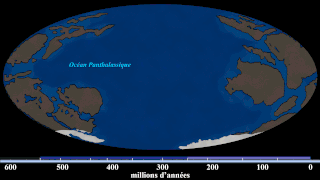
The Cryogenian is a geologic period that lasted from 720 to 635 million years ago. It forms the second geologic period of the Neoproterozoic Era, preceded by the Tonian Period and followed by the Ediacaran.
The International Commission on Stratigraphy (ICS), sometimes unofficially referred to as the "International Stratigraphic Commission", is a daughter or major subcommittee grade scientific daughter organization that concerns itself with stratigraphical, geological, and geochronological matters on a global scale.
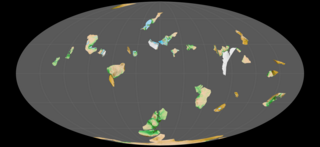
The Rhyacian Period is the second geologic period in the Paleoproterozoic Era and lasted from 2300 Mya to 2050 Mya. Instead of being based on stratigraphy, these dates are defined chronometrically.

The Orosirian Period is the third geologic period in the Paleoproterozoic Era and lasted from 2050 Mya to 1800 Mya. Instead of being based on stratigraphy, these dates are defined chronometrically.

The Statherian Period is the final geologic period in the Paleoproterozoic Era and lasted from 1800 Mya to 1600 Mya. Instead of being based on stratigraphy, these dates are defined chronometrically.

The Calymmian Period is the first geologic period in the Mesoproterozoic Era and lasted from 1600 Mya to 1400 Mya. Instead of being based on stratigraphy, these dates are defined chronometrically.
First appearance datum (FAD) is a term used by geologists and paleontologists to designate the first appearance of a species in the geologic record. FADs are determined by identifying the geologically oldest fossil discovered, to date, of a particular species. A related term is last appearance datum (LAD), the last appearance of a species in the geologic record.
The Furongian is the fourth and final epoch and series of the Cambrian. It lasted from 497 to 485.4 million years ago. It succeeds the Miaolingian series of the Cambrian and precedes the Lower Ordovician Tremadocian Stage. It is subdivided into three stages: the Paibian, Jiangshanian and the unnamed 10th stage of the Cambrian.
The Santonian is an age in the geologic timescale or a chronostratigraphic stage. It is a subdivision of the Late Cretaceous Epoch or Upper Cretaceous Series. It spans the time between 86.3 ± 0.7 mya and 83.6 ± 0.7 mya. The Santonian is preceded by the Coniacian and is followed by the Campanian.
The Paibian is the lowest stage of Furongian series of the Cambrian. It follows the Guzhangian and is succeeded by the Jiangshanian Stage. The base is defined as the first appearance of the trilobite Glyptagnostus reticulatus around 497 million years ago. The top, or the base of the Jiangshanian is defined as the first appearance of the trilobite Agnostotes orientalis around 494 million years ago.
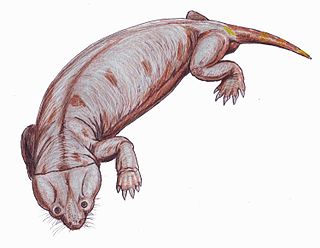
The Cistecephalus Assemblage Zone is a tetrapod assemblage zone or biozone found in the Adelaide Subgroup of the Beaufort Group, a majorly fossiliferous and geologically important geological group of the Karoo Supergroup in South Africa. This biozone has outcrops located in the Teekloof Formation north-west of Beaufort West in the Western Cape, in the upper Middleton and lower Balfour Formations respectively from Colesberg of the Northern Cape to east of Graaff-Reinet in the Eastern Cape. The Cistecephalus Assemblage Zone is one of eight biozones found in the Beaufort Group, and is considered to be Late Permian in age.
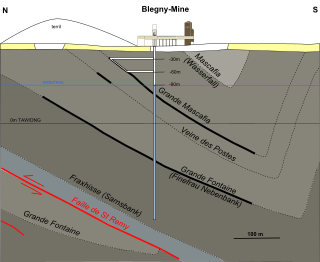
A stratigraphic section is a sequence of layers of rocks in the order they were deposited. It is based on the principle of original horizontality, which states that layers of sediment are originally deposited horizontally under the action of gravity.
The Floian is the second stage of the Ordovician Period. It succeeds the Tremadocian with which it forms the Lower Ordovician epoch. It precedes the Dapingian Stage of the Middle Ordovician. The Floian extended from 477.7 to 470 million years ago. The lower boundary is defined as the first appearance of the graptolite species Tetragraptus approximatus.

The Bulletin of Engineering Geology and the Environment is a peer-reviewed scientific journal covering research in the field of engineering geology. It is the official journal of the International Association for Engineering Geology and the Environment and published on their behalf by Springer Science+Business Media. According to the Journal Citation Reports, the journal has a 2020 impact factor of 4.298.
The Guzhangian is an uppermost stage of the Miaolingian Series of the Cambrian. It follows the Drumian Stage and precedes the Paibian Stage of the Furongian Series. The base is defined as the first appearance of the trilobite Lejopyge laevigata around 500.5 million years ago. The Guzhangian-Paibian boundary is marked by the first appearance of the trilobite Glyptagnostus reticulatus around 497 million years ago.
The Miaolingian is the third Series of the Cambrian Period, and was formally named in 2018. It lasted from about 509 to 497 million years ago and is divided in ascending order into 3 stages: the Wuliuan, Drumian, and Guzhangian. The Miaolingian is preceded by the unnamed Cambrian Series 2 and succeeded by the Furongian series.

Palaeoworld is a peer-reviewed academic journal with a focus on palaeontology and stratigraphy research in and around China. It was founded in 1991 by the Nanjing Institute of Geology and Palaeontology at the Chinese Academy of Sciences (NIGPAS). The journal has been published quarterly since 2006; prior to 2006, it did not adhere to a fixed publication schedule.
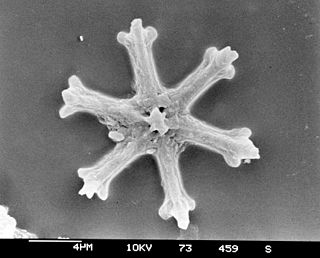
Calcareous nannofossils are a class of tiny microfossils that are similar to coccoliths deposited by the modern-day coccolithophores. The nannofossils are a convenient source of geochronological data due to the abundance and rapid evolution of the single-cell organisms forming them (nannoplankton) and ease of handling of the sediment samples. The practical applications of calcareous nannofossils in the areas of biostratigraphy and paleoecology became clear once the deepwater drilling took off in 1968 with the Deep Sea Drilling Project, and they have been extensively studied ever since. Nannofossils provide one of the most important paleontological records with the contiguous length of 220 million years.










